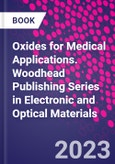Oxides for Medical Applications reviews the most important advances of oxides with optical, magnetic and electronic properties for biomedical applications. Owing to their unusual properties, oxides are expected to play a significant role in the prevention or early treatment of diseases. In addition to catalytically active artificial enzymes based on oxide materials-the book provides comprehensive coverage of the most relevant categories of oxide materials and their properties and applications. Since magnetic oxides are used extensively for a wide range of medical applications, there are numerous chapters that address these materials, including LSMO nanoparticles, ferrites, nanocatalysts, and more.
Finally, practical considerations for the translation of these materials from the lab to the clinic are reviewed, including biocompatibility and toxicity of oxide nanoparticles, making this a suitable resource for researchers and practitioners in materials science and engineering in academia and the clinic.
Please Note: This is an On Demand product, delivery may take up to 11 working days after payment has been received.
Table of Contents
1. An overview of biomedical applications of oxide materials2. Particle Specifications of Oxide Materials for Biomedical Applications
3. An Overview on the Traditional Methods of Synthesis of Oxide Nanoparticles for Medical Applications
4. Synthesis of Graphene & Graphene Oxides and Their Medical Applications
5. Synthesis of Silica Oxide Nanoparticles and Their Medical Applications
6. Synthesis of TiO2 Nanostructures and Their Medical Applications
7. Synthesis of ZnO Nanostructures and Their Medical Applications
8. Rare Earth Oxides and Their Medical Applications
9. Synthesis of Iron based Nanoparticles by Chemical Methods and Their Medical Applications
10. Core-shell Oxide Nanoparticles and Their Biomedical Applications
11. Role of LSMO Magnetic Nanoparticles in Nanomedicine
12. Zinc Ferrite Nanoparticles and Their Biomedical Applications
13. Magnetic Nanoparticle and Enzyme Interface
14. Magnetic Recyclable Nanocatalysts for Cancer Treatment
15. Catalytically Active Nanomaterials as Artificial Enzymes
16. Oxides, Oxidative Stress and Cellular aging
17. Oxides and Neuropsychiatric and Neurodegenerative Disorders
18. Zirconia and its Derivatives and Their Medical Applications
19. ROS mediated pathogens killed by ZnO and MgO Nanoparticles
20. Oxides Nanoparticles in context of Covid-19 Detection
21. Biocompatibility and Toxic effects of oxide nanoparticles: Implications for Public Health and Risk Assessment








